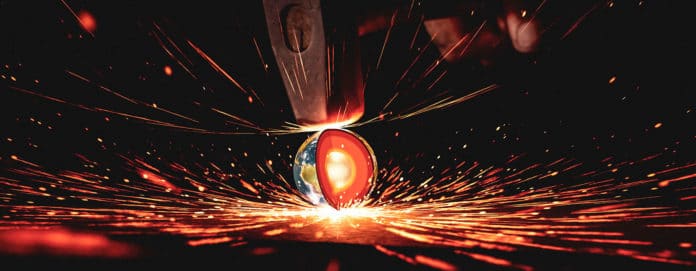Our understanding of planetary cores mainly relies on experimental studies of metals at less extreme temperatures and pressures. In a new study, scientists at the Department of Energy’s SLAC National Accelerator Laboratory have observed how iron’s atomic structure deforms to accommodate the stress from the pressures and temperatures that occur just outside of the inner core.
The iron atoms are arranged in nanoscopic cubes, with an iron atom at each corner and one in the center. Squeezing these cubes using high pressures rearranges them into hexagonal prisms. These prisms pack the atoms more tightly.
Scientists wanted to determine what would happen if you kept applying pressure to that hexagonal arrangement to mimic what happens to iron at the Earth’s core or during atmospheric reentry from space.
Co-author Arianna Gleason, a scientist in the High-Energy-Density Science (HEDS) Division at SLAC, said, “We didn’t quite make inner core conditions. But we achieved the conditions of the outer core of the planet, which is remarkable.”
“Until now, no one has observed the iron’s response to stress under such high temperatures and pressures. As we continue to push it, the iron doesn’t know what to do with this extra stress. And it needs to relieve that stress, so it tries to find the most efficient mechanism to do that.”
Iron uses a coping mechanism called twinning to deal with that extra stress. This mechanism shunts the arrangement of atoms to the side, rotating all the hexagonal prisms by nearly 90 degrees.
Gleason said, “Twinning allows iron to be incredibly strong — stronger than we first thought — before it starts to flow plastically on much longer time scales.”
The team used two types of laser to reach these extreme conditions. The first was an optical laser, which generated a shock wave that subjected the iron sample to extremely high temperatures and pressures. The second was SLAC’s Linac Coherent Light Source (LCLS) X-ray free-electron laser, which allowed the iron observation on an atomic level.
Lead author Sébastien Merkel of the University of Lille in France said, “At the time, LCLS was the only facility in the world where you could do that. It’s been a door opener for other similar facilities in the world.”
Scientists fired both lasers at a tiny sample of iron about the width of a human hair. It created a loud pop.
At the same time, using an X-ray laser, scientists observed how the shock changed the arrangement of the iron atoms.
Gleason said, “We were able to measure a billionth of a second. Freezing the atoms where they are in that nanosecond is exciting.”
Scientists collected these images and assembled them into a flipbook that showed iron deforming.
Merkel said, “The fact that the twinning happens on the time scale that we can measure it as an important result in itself.”
This study offers exciting insights into the structural properties of iron at extremely high temperatures and pressures. It is also a promising indicator that these methods could help scientists understand how other materials behave in extreme conditions, too.
Gleason said, “The future is bright now that we’ve developed a way to make these measurements. The recent X-ray undulator upgrade as part of the LCLS-II project allows higher X-ray energies — enabling studies on thicker alloys and materials that have lower symmetry and more complex X-ray fingerprints.”
Journal Reference:
- Sébastien Merkel et al. Femtosecond Visualization of hcp-Iron Strength and Plasticity under Shock Compression. DOI: 10.1103/PhysRevLett.127.205501
